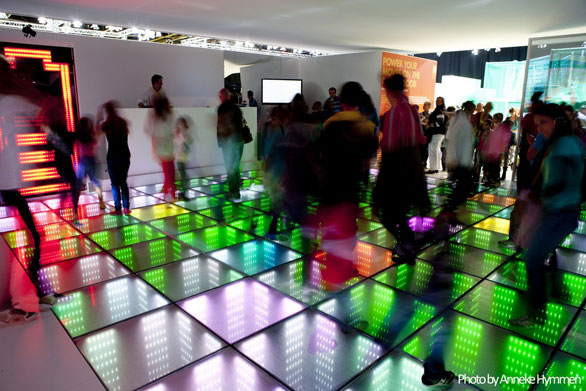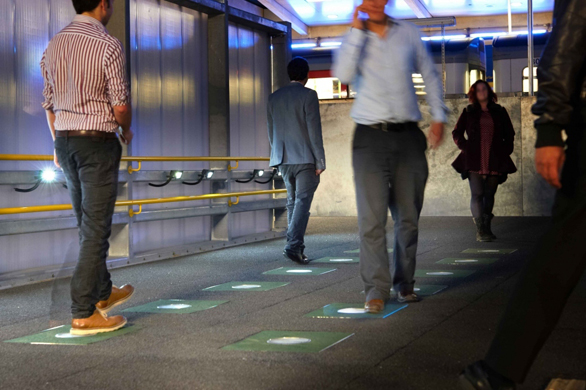
Sustainable Dance Floor doesn’t just light up—it generates electricity as you dance. Photo: Anneke Hymmen, courtesy of Energy Floors
The average person takes about 150 million steps in a lifetime. What if we could turn all that movement into energy? Two innovators are working on it — including a TED@London speaker. While one has built a system to capture the energy of foot traffic, the other is harnessing the power of smooth dance moves.
Mashable directs our attention to Energy Floors, a groovy company based in Rotterdam that has used dancefloor power to create more than 8 billion joules of electricity so far. In 2008, the team created Club WATT — an ecological dance club with flooring tile that harnesses the ecstatic movements of dancers, converting kinetic energy to actual electricity. Their first big idea: Launch a network of sustainable dance clubs with glowing, interactive floors, while simultaneously launching a line of floor tiles called Sustainable Dance Floor. But as CEO Michel Smit tells the TED Blog, that business model proved unsustainable, so the company shifted its focus toward using dance floors to raise awareness of energy usage.
Enter the Mini Sustainable Dance Club, tiny portable dance clubs that fit six to eight people. These can-shaped rooms are step-activated, so when curious visitors walk up the three stairs, the club ignites into an interactive and intimate experience that gives dancers visual feedback — the more enthusiastic the dancers are about getting into the groove, the more the illuminated illustrations on the walls intensify. When a threshold is reached, a mirrored disco ball spins. These “clubs in a can” can be set up by two people, and are naturally becoming a hit at outdoor festivals.

PaveGen floor tiles catch the energy of everyday walking. Here, they appear in London’s West Ham Underground station. Photo: Courtesy of PaveGen
This idea of regenerative energy flooring is similar to one we’ve seen presented on the TED stage. Laurence Kemball-Cook, a London-based industrial design engineer, was working at one of Europe’s largest energy companies when he set his sights on making the power in cities more sustainable. In a country prone to overcast and mild weather, solar and wind energy are anything but practical. But he had another idea.
During TED’s worldwide talent search stop in London, Kemball-Cook gave a talk about PaveGen, his technology company that develops sustainable flooring tile. The flooring tile, made out of things like recycled truck tires, works to convert the kinetic energy created from a footstep into electrical energy that can light pathways (and even tweet).
After Cook installed PaveGen tiles at music festivals and the 2012 London Olympics, as well as in school hallways, he realized that people were gravitating toward his system because of the instant feedback it gives. Which is exactly what makes the Mini Sustainable Dance Club such a fun idea too.
Comments (19)
Pingback: Can Decentralized Sustainable Energy Generated by Crowds Become a Long-term Power Source, or is it just Virtue Flag Waving? | Biz Builder Mike
Pingback: Kinetic Dance Floors To Power Clubs And Concerts - swiftheadline
Pingback: People Power: Kinetic Dance Floors To Power Clubs And Concerts - The Real Preneur
Pingback: 5 fontes de energia alternativas incomuns que você nunca ouviu falar | Dicas & Curiosidades™
Pingback: Harvesting human energy – Artists & Climate Change
Pingback: ¿Cuánto saltarías por una tostada gratis?
Pingback: Renewable energy – one step at a time! | I want to save the world today!
Pingback: Save the world with your feet | Liberal Marketplace